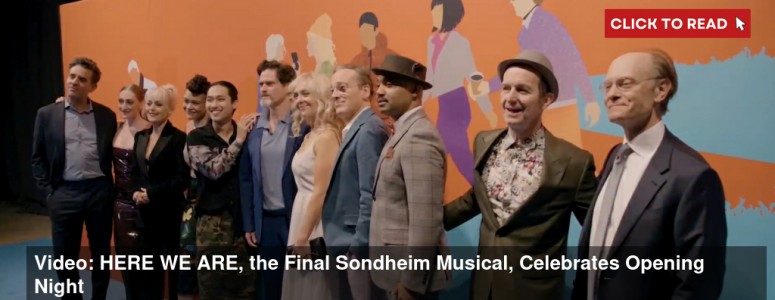“What a perfect day!”
It’s the opening line of the first new Stephen Sondheim song that we’ve heard in years.
Does it also serve as an apt description of HERE WE ARE, the final work of Broadway’s greatest composer-lyricist?
No, of course not. Perfection would be too much to ask of the musical that Sondheim did not live to polish, or even finish.
Many of us never expected to see this show. But here’s HERE WE ARE at The Shed.
Let’s consider ourselves lucky to have had the chance to learn how much progress Sondheim had made through November 26, 2021.
His 1994 musical PASSION was based on one foreign film; this one is based on two: Luis Bunuel’s THE DISCREET CHARM OF THE BOURGEOISIE and THE EXTERMINATING ANGEL.
At the Shed, they’re done in that order – the reverse of how Bunuel had handled them; he did ANGEL first in 1962, ten years before DISCREET.
Bunuel used completely different characters in each film, as would be expected from two unrelated properties that were filmed a decade apart. Sondheim and/or bookwriter David Ives wisely decided to make the same people inhabit both halves.
HERE WE ARE has been updated to what feels like the here and now. Ives has set his libretto uses colloquial everyday American language: shmuck, ta-da, brain fart.
He’s retained both plots. DISCREET’s has four people arrive for dinner at a private home only to be told by the host that they’re 24 hours early. All get in their cars and drive to find a restaurant.
The film took place in rustic France 52 years ago, where take-out wouldn’t seem to be a ready option; the group is forced to find a restaurant. Given that we’re in 2024 and apparently in the United States, why doesn’t the host just make the phone call?
A LITTLE NIGHT MUSIC offered us cars; HERE WE ARE doesn’t. There’s virtually no scenery in what is really a glorified black-box production, except that here the dominant color is white.
So it’s a white-box production. But what Sondheim show didn’t do the reverse of what was expected?
However, David Zinn, who designed both sets and costumes, did find a smart way of getting onto the stage a large restaurant table.
It’s all these characters are going to get. Here’s where Bunuel went for the surrealistic, which was always his most comfortable comfort zone. Although the restaurant is open, it had absolutely no food available. What Ives calls Café Everything has nothing.
“Nothing” isn’t so far afield from a word you’d use to describe these people who think they’re really something (despite the way that some of them made their money). They show their sense of entitlement when they enter a crowded restaurant and expect they’ll get in because “We’re regulars here,” which we don’t believe any more than the host does. They don’t come close to getting dessert, but we get some schadenfreude when they get their just desserts.
Act Two starts modestly, but soon Zinn’s white box gives way to a very handsome drawing room filled with filled bookshelves. Sure, going without a meal when you’re hungry isn’t much fun. But it’s nothing compared to being in a room where you simply don’t have the power to leave.
Yes, you read that right, and this comes directly from Bunuel: they’re stuck in a room from which they cannot for the life of them leave. Don’t misunderstand; neither a fierce snowstorm nor machine-gun toting soldiers are the reason. They simply get as far as the threshold and something – who knows what? – stops them from crossing it.
The point seems to be that it wouldn’t take much to humiliate and scare the rich and powerful into becoming Just Like the Rest of Us. When the going gets tough, they don’t know where they’re going. If you thought ANYONE CAN WHISTLE’s Cookies were crackers, you should see this group. How a servant relishes the chance to grab the upper hand and twist everyone else’s.
Ives skillfully details the vapidity of this crowd. One is the type who asks the waiter a question that he should answer himself: “Do I want the duck?” Another amazes when she lists one advantage of cloning that, virtually safe to say, has not occurred to any of us. And what about a character who worries about one who disappears because “Who’s going to tell us now where to buy sunglasses in Stockholm?”)
There are other surprises. In your many trips to the theater, when you’ve seen the house lights come up, you applaud because it’s intermission. Here when they do, you may very well laugh instead.
The 21st century has provided audiences many opportunities to applaud heartily when a singer holds a note for an inordinate amount of time. Sondheim’s audience is more sophisticated, so while the held note can rival any of the many on Broadway right now, it’s of an entirely different variety.
Making a sudden out-of-nowhere appearance is a priest who “Does anybody here have any spiritual needs.” We soon find what his needs are.
All right, but first and foremost, we’re here at HERE WE ARE to hear Sondheim’s score. Much has been said about the paucity of music in Act Two. Is it because these people have been struck inarticulate? Perhaps the intention was always to have them speak rather than sing.
However, Sondheim often said that he sequentially wrote his songs; for example, only after he had finished “The Ballad of Sweeney Todd” did he tackle “No Place Like London” before moving on to “The Barber and His Wife.” With this in mind, perhaps Sondheim only got as far the songs we now hear and Ives’ dialogue had to finish the rest.
We must wonder about a sequence between a soldier (Jin Ha) and a revolutionary (Michaela Diamond) who share a Tony-and-Maria attraction. Ives has written them dialogue reminiscent of CANDIDE’s “Oh, Happy We.” Had Sondheim the time, would he have turned it into a song? Or would he have felt that Leonard Bernstein and Richard Wilbur had already covered that ground and that Ives should do the talking?
Hearing someone say “It’s your fault,” “I’m still here,” “Bang!” and a mention of the novel The Red and the Black may make you nostalgic, or make you wonder why Ives didn’t choose other expressions that would keep us in the play and not the past.
But we come here to HERE WE ARE for the score, don’t we? More than once you’ll be reminded of Sondheim’s melodies that you’ve known and loved. All the echoes of his previous songs will allow you to make a choice: welcome them into your heart and brain as a type of Stephen Sondheim Retrospective – or say (far less graciously) that the score is an AI version of Sondheim.
His lyrics seldom if ever go for trickiness that we’ve savored a la “sunset/unsettling” or “Danube-y/how can you be.” The perceptions are Sweeney-razor sharp, though, such as one that cites “Underpaid teachers and overpaid actors.”
Some members of this cast may take issue with the final two words; how much could an off-Broadway salary be these days – and certainly in comparison with the far greater monies that many of these people have been accustomed to receiving? Here’s betting, though, that the chance to originate a role in a new Sondheim musical made them say yes the moment they were asked no matter how few sheckles they’d get.
Two of the most acclaimed performers apparently didn’t even worry about the size of their roles. As a priest, David Hyde Pierce doesn’t arrive until dozens of minutes have passed. Tracie Bennett proves that hell, she’d even play the maid to be in the show.
What other musical in own can boast three Tony-winners (Pierce, Rachel Bay Jones, and Denis O’Hare) and five who have been Tony nominated (Bennett, Bobby Cannavale, Micaela Diamond, Amber Gray and Jeremy Shamos)? And while we’re clocking Tonys, Ives who’s mostly worked off-Broadway, has received a nomination as well, and Joe Mantello has snagged six in the Best Direction categories en route to two wins.
As for Sondheim, who has the time to count all his?
All in all, this is – pun very much intended – a tony crowd. It’s also one that Mantello has steered in the right direction with one small misstep. He might have indicated earlier in Act Two that these people simply don’t have the ability to leave the room. That’s eventually made clear, but establishing it some minutes earlier would have been better for those unfamiliar with the Bunuel film.
All in all, HERE WE ARE is one of those “But what does it mean?” shows that will make some feel as if they’ve gone to the theater on the wrong night.




